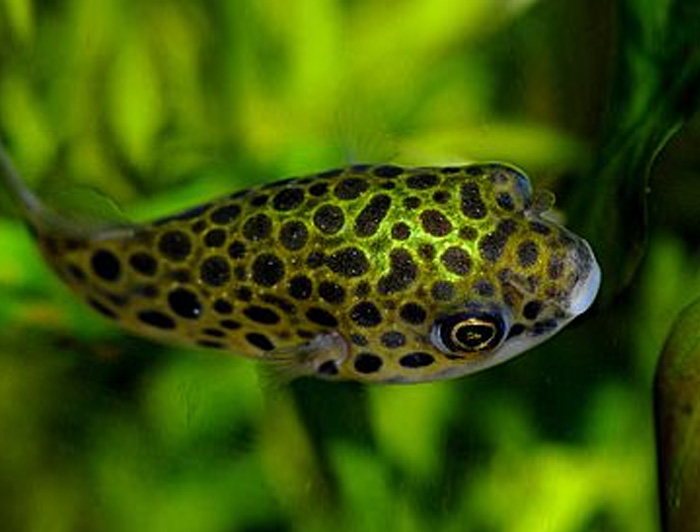Green Spotted Puffer
Green Spotted Puffer (Tetraodon nigroviridis)
The Green Spotted Pufferfish belongs to the Tetraodontidae family. In the wild, they inhabit regions where freshwater and saltwater mix, and in captivity, they should be kept in brackish water. LiveAquaria® suggests maintaining a salinity of 1.0 to 1.2 and a pH of 7.5-8.0 for optimal health.
Caring for a Green Spotted Pufferfish is a long-term commitment, as they can live up to 10 years. Sometimes called the Spotted Puffer or Leopard Puffer due to their green bodies with dark spots and white underbellies, these fish have prominent eyes and a distinctive appearance.
As a larger, aggressive species that can reach up to 6 inches or more, they make a striking addition to a brackish aquarium. Their unique traits include the ability to puff up their bodies when threatened and strong jaws with four crushing plates instead of teeth, which continuously grow throughout their lives. To manage these plates, they require a diet rich in shellfish. Their powerful pectoral fins also enhance their swimming agility. Notably, they lack scales, so maintaining proper water conditions is crucial. Their leathery skin contains neurotoxins that provide protection from predators.
Green Spotted Puffers are not ideal for community tanks, as they may not get along with other fish and can be fin-nippers, particularly when hungry. For guidance on compatible tankmates, consult LiveAquaria’s Compatibility Chart. Despite these challenges, their active behavior and distinctive appearance make them appealing to many hobbyists, who often feel a personal connection with their Pufferfish.
Avoid overfeeding, as these fish will eat excessively and may even consume themselves to death. Their diet should consist primarily of meaty foods, such as shellfish, snails, mollusks, brine shrimp, krill, earthworms, and plankton, to help manage their oral plates.
For their aquarium, provide brackish water with plenty of hiding spots and open swimming areas. Use plants (real or plastic), rocks, or driftwood, and a substrate of fine sand, which helps wear down their oral plates.
Approximate purchase size: 1 to 2 inches.
